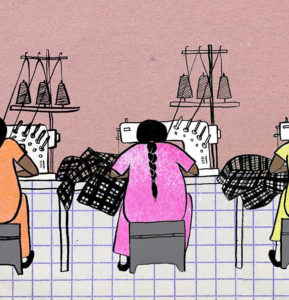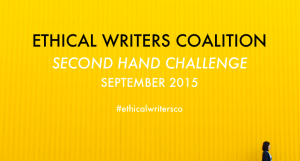This interview has been kindly sponsored by COB Designs.
[/vc_column_text][vc_separator][vc_column_text]Charlene’s clothes precede her.At least they did for me. When the ethereal dress I’m wearing above came down the runway at Global Sustainable Fashion Week last month in Budapest, I was hooked. I had to meet the designer. After we both came off the adrenalin of our big days – my lecture, her runway show – we spent a day together at the famous Széchenyi thermal baths where we shoot these photos. And because, hey, we needed some post-conference R&R.
Charlene produces her namesake sustainable fashion line, COB Designs, out of her studio in verdant Western Australian. In this interview, she tells me about the secret to her longevity in sustainable fashion (she’s been at it 20 years!), her approach to zero-waste, and what makes her designs so unique.[/vc_column_text][vc_column_text]
I love that this dress strikes a balance between bold and breezy, making it so wearable. You started to tell me the story behind it at the conference. How you traveled to Japan to hand-pick a vintage Kimono to reconstruct. You’ve done this for other dresses in your collection too. How did you come up with the concept?
I have to take you back in time to answer this one. I started out as an eco-fashion designer in 1997 and made it a commitment from day one to consider the impact of my designs. I’ve honored this commitment primarily by sourcing eco and repurposed fabrics. So I scour the globe for the best ones! When I create a designer piece by reconstructing a new garment from something I find that’s still beautiful, it honors principles of zero-waste and helps cut down on waste in the fashion industry. The kimono I chose here is made from 100% silk and in its past life was handmade by a Japanese seamstress. When I reconstruct it, I take this into account. I’m careful to honor the original construction as I restyle it into a modern, wearable piece with my own hand stitching techniques. Born anew!
And why did you choose to upcycle kimono’s instead of other materials, say, ones that you could find where you’re based in Perth?
Japanese silk is beautiful! It caught my eye on a trip to Japan and it’s been a love affair since. I enjoy working with silk and love how it falls and feels sumptuous on the body of the wearer. Kimono vintage silk is a natural fiber that comes in a myriad of vibrant colours, with many motifs and patterns available such as floral prints to rich embroidered exotic birds and flowers. Each piece offers a unique interpretation of the cloth used and evolves to become an art piece, exclusive in its own right.
A shorter rendition of Charlene’s kimono dresses
[/vc_column_text][/vc_column][/vc_row][vc_row][vc_column][vc_single_image image=”2449″ img_size=”large” add_caption=”yes” alignment=”center”][/vc_column][/vc_row][vc_row][vc_column][vc_column_text]Your kimono dresses are just one part of your namesake line. Those bridal dresses you sent down the runway were also stunners. At first, I didn’t realize they were wedding dresses! I thought, “Oh, that’d be great for the next dressy-ish outdoor event I get invited to in Austin.” Your approach is what most women tell me they want nowadays: to be simple, natural, but still unique on their wedding day. They’re overall all the hype and fuss. Is this what you’re hearing too?
Absolutely! These wedding dresses are romantic, elegant, and can be worn again on other special occasions. My clients tell me they like to wear them to the beach and some even flip the script and wear them as wedding guests, especially for outdoor occasions. They are ‘one off’ pieces I create from 100% silk and a natural dying process. That feminine pink hue comes from a delicate process I created using fresh strawberries. I never touch AZO.
I also use hand techniques to achieve the subtle embellishments that create the dresses unique shape. My favorite details are beading and felting with Australian merino wool. The felting I especially love because it really makes my dresses distinctive. Make sure to check out a wedding dress site to see which dresses and styles suit you, is always the best thing to do before all eyes are on you down the aisle! Whichever you choose, make sure it’s right for you.
You told me some of the wedding dressed in your line are Fair Trade. That’s not something I see very often in the bridal industry. How did you make it happen?
Yes, it’s a project that took quite a while to materialize. It’s the result of a collaboration with an Australian fashion designer who contacted me in 2016 after she set up a Fairsew workshop in Cambodia. I visited her studio to learn about her production and she introduced me to sourcing sustainable, fair trade silks. Seeing how transparent she was able to be through Fair Trade inspired me. I decided to design a cost-effective range of wedding dresses, stay committed to sustainable sourcing, while also adding a new piece – supporting micro business. The artisans who make these dresses are able to support their own businesses and do so in a safe and happy work environment. [More on that here.]
A COB wedding dress at Global Sustainable Fashion Week
[/vc_column_text][/vc_column][/vc_row][vc_row][vc_column][vc_single_image image=”2448″ img_size=”large” add_caption=”yes” alignment=”center”][vc_column_text]So, fair trade is your approach in one of your bridal ‘ranges’ but you also have two other lines in COB. How do you approach sustainability in those?
There are so many aspects to sustainability, which makes eco fashion a really creative industry. I love a challenge and this industry forces me to be innovative and resourceful with my designs. I take every aspect of my garments into consideration. One part is chemicals, which I address with my dyeing process and in the fabrics I choose. I mentioned the dye made from strawberries that I use for my fair trade dresses; this carries into my other lines. Everything is natural, clean, chemical-free. I source the botanicals for dyes in my other lines from native Australian bush plants. Mainly, gum nuts, bark, fungi, and various palms and leaves. I also source certified organic Australian merino wool for my hand felting.
The other part is waste and reuse. I address this by purchasing luxury ‘cast-offs’ directly from conventional fashion designers and combining them to create my own tops, dresses, skirts and couture bridal pieces.
Forgive me, this one is a bit of a cliche, but I always like to ask “who are you designing for?” because I think aesthetics are the most important thing.
I design for the woman who radiates an inner sense of beauty and confidence. She is ultra feminine, unassumingly artistic, poetic and romantic. Her earthiness denotes strong values of whom she is and enjoys the unusual and sublime. Her expression is extremely unique.
Okay, let’s talk sustainability now. When I approach designers about this I often have to be super clear about what I mean since it can be interpreted in many ways. You, for instance, seem to be really focused the waste reduction aspect of sustainable fashion. In addition to upcycling kimonos you’re also focused on manipulating your garments as little as possible to reduce waste. Why this approach?
Because I like to create a dress with no mess. For me, zero-waste fits my skill set because it’s one of the most creative niches in sustainable fashion. Within it, I have evolved my own concept where I manipulate the fabric entirely by hand, stitching and felting an entirely new creation without the use of conventional construction methods like patterns making, darts, and cutting.
[/vc_column_text][/vc_column][/vc_row][vc_row][vc_column][vc_column_text]It’s challenging to go against convention. For you, what’s the hardest part of sustainable design?
Patience and flexibility. The fabrics I chose govern my design and because many of my processes are natural, I have to constantly remind myself to lets things gradually evolve.
Whether it’s waiting for a stark white piece of silk to be transformed inside a brewing pot of botanical dye or searching for two different reclaimed materials that can mesh together to make a new garment, each process is a journey. Really, it’s wearable art.
To me, a white piece of silk is like a painter’s blank canvas.
My designs aren’t whipped up like fast fashion. They’re a product of an array of skills I’ve developed through years with a special attention to thoughtfulness and sustainability.
You were really ahead of the whole ‘eco’ curve in fashion, having started your line in 1997. Take me back in time to your first collection.
My very first lifestyle collection for men and women was made from recycled denim. I collected denim waste from factory off cuts, which otherwise were destined for the landfill. Then, I had the scraps shredded and re-spun them back into a yarn to become bags, wraps, tops, cardigans, and jumpers.
They were made by hand in a Vietnam community and helped to support their knitting and crochet cottage industry. The production small and, again, because the designs were handcrafted, there was no waste created [knitters are taught to use all the yarn to create a piece from start to finish]. It was a thriving business where I was able to support women in business before I branched into Fair Trade. This really set the stage for that part of my line.
How about where you live in Western Australia, has it impacted your design approach? What’s the sustainable fashion scene is like there?
The sustainable fashion scene is still very niche in Western Australia but it’s growing as other designers come on board. I think I’ve been successful because I’ve stocked my designed in a few social enterprise stores and galleries especially set up for artists to sell their work. For the past three years, I’ve also participated in open studios with 20+ other artists. They take place each spring and draw both locals and visitors alike who come to see the wildflowers and tulips blossoming. So there’s an innate sense of appreciation for the outdoors, which is helping sustainable fashion grow more here.
And your evolution to today. How have you endured and stayed relevant as a sustainable designer?
Creative thinking. Sustainable fashion is about more than just designing with ethics. I like coming up with new design ideas, things people haven’t seen before, and that evolution, I think, has helped me stay relevant. That, plus travel. When I visit new places, like coming to Budapest to attend GSFW, it not only inspires me but it helps me get a sense for what’s new globally. It’s also how I know where to find the best vintage textiles.
From the runway to the Széchenyi baths, Budapest.
[/vc_column_text][vc_gallery interval=”3″ images=”2452,2453″ img_size=”large”][/vc_column][/vc_row][vc_row][vc_column][vc_column_text]Given your staying power in sustainable fashion, what can other designers learn from your success?
I would encourage other designers to think about their impact on the environment from every angle from business operations to production, especially if they are just starting. This way, they won’t have to switch halfway through from conventional to eco fashion methods. Research, learn from other designers, ask questions, and have an inquiring mind, There is unlimited potential for you in this field – and we need more designers.
Okay, getting theoretical on you! Do you think sustainable design will ever fully replace conventional, fast-fashion?
Well, it is a good question! I feel for sustainable design to make it mainstream, it will take a while. It will require a fundamental change on how one chooses to shop and buy a product in order to create demand for more sustainable products. And you have to factor in availability here too. For instance, where can you find the product? Specialty shops or collectives?
It seems like today there are more online stores popping up for local artisans to sell their work. It would be a dream come true if more consumers bought directly from the artists and collective stories. My hope is that this will be the new shopping hype rather than stress-ridden multinational shopping centers that serve fast fashion today.
As an indie designer, do you feel pressure from larger brands with cheaper goods?
Absolutely. This pressure actually led me to change my designs and distribution channels. Now, my focus is more narrow and I have to really understand my customer because I can’t compete with mass-produced brands that keep prices down with cheap labour. So you either want to express your self as an individual by wearing apiece made direct by the designer for a little extra cost, or wear something that anyone else can wear. Factor in that you don’t know under what conditions the garment is made, how or by whom.
I’m going after women who want to express themselves as individuals by wearing a piece made direct by me. They’re willing to pay a little extra cost for unique design and to be assured that their garment is made under fair conditions.
I hear that! Okay, I saved the hardest question for last. You hinted at it, but I’m curious to know what you think about the high cost of sustainable fashion. I feel it’s a justified expense, especially when I meet someone like you and learn how much work goes into the slow fashion process. But many people tell me that I’m nuts for recommending clothing upwards of $500 to people in my age demographic (25-37). Do you come up against this challenge and, if so, how do you handle it?
For me, it is an easy expense to work out logically because I justify it as a quality investment. I ask this question: if a dress is $500, wouldn’t you spend that much on many items in a year that are ‘seasonal’?
Multinational clothing brands make things to last a short time so that they become disposable. This is a boon to their profits but a detriment to the environment. One store I visited when I started [I was vetting it as a potential stockist for COB], told me my clothes weren’t disposable enough. They said they needed lines that would turn over fast and drive sales. That was really tough to hear when I was just starting out as an eco-fashion designer. But, in a way, it just motivated me to push harder.
I want to be the designer who comes from a place of integrity and makes garments to last a long time. Who is transparent in her production methods and fabric sourcing. Personally, I’m happy with a smaller wardrobe of beautiful unique clothing and I hope people who come to me for designs will be too.
How can readers get the dress I’m wearing?
The dress can be purchased online from my website. It is custom made to fit any size and I would need your personal measurements of Bust, Waist, Hips to be fitted to your size.




